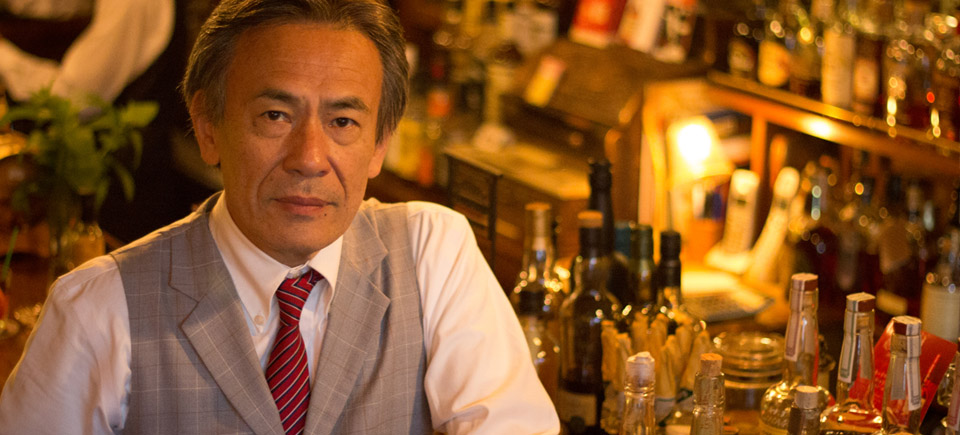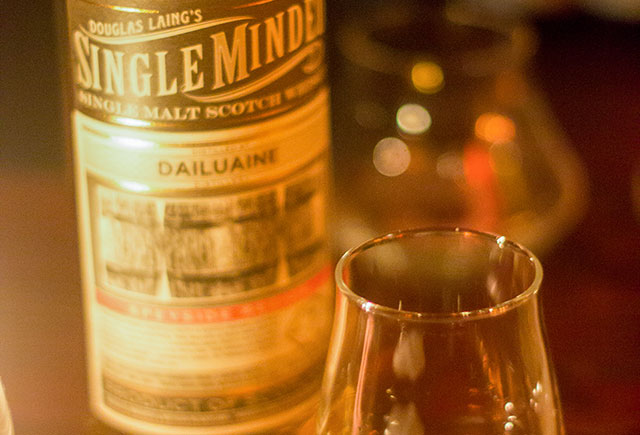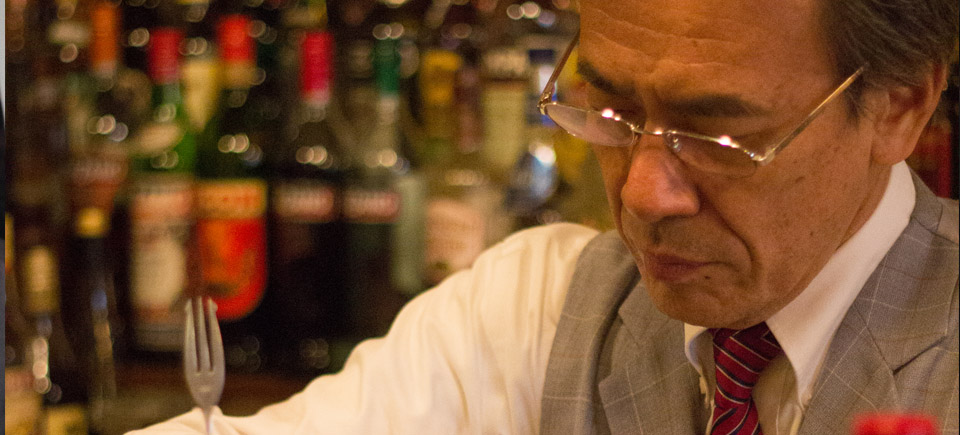Feature
Rogin’s Ode to Whiskey
Poetry for the palate: A Moriguchi man’s love of whiskey has taken him across the world and back, and now he’s Kansai’s go-to man for a true taste of the past.
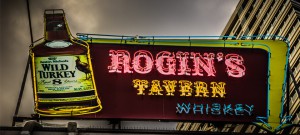 One look inside this place and you know there’s a special story hidden behind the crystal ware and decades-old merchandise and memorabilia. Hundreds of bottles of whiskey line giant old-fashioned wooden shelves that stretch the length of the bar, harking back to a time long past. There are whiskies and bourbons new and old. Familiar faces like Jack Daniels, Jim Beam, and Four Roses alongside bottles that are over 100 years old with faded labels of brands that, to many, are now unheard of. Music floats gently from the far corner where there sits a jukebox that looks like it belongs in an antique shop or a museum. The soothing sounds of Nat King Cole draw guests into this whiskey lovers’ dreamland, accompanied by a ching! – the sound of the evening’s sales chiming from an equally rustic-looking cash register. Patrons trickle in, preparing to be carried away to another time and place by Rogin’s Tavern, whiskey and bourbon bar extraordinaire.
One look inside this place and you know there’s a special story hidden behind the crystal ware and decades-old merchandise and memorabilia. Hundreds of bottles of whiskey line giant old-fashioned wooden shelves that stretch the length of the bar, harking back to a time long past. There are whiskies and bourbons new and old. Familiar faces like Jack Daniels, Jim Beam, and Four Roses alongside bottles that are over 100 years old with faded labels of brands that, to many, are now unheard of. Music floats gently from the far corner where there sits a jukebox that looks like it belongs in an antique shop or a museum. The soothing sounds of Nat King Cole draw guests into this whiskey lovers’ dreamland, accompanied by a ching! – the sound of the evening’s sales chiming from an equally rustic-looking cash register. Patrons trickle in, preparing to be carried away to another time and place by Rogin’s Tavern, whiskey and bourbon bar extraordinaire.
“Did you know Nat King Cole used to sing in Japanese?” says bar owner Seiichiro Tatsumi as he sniffs a more than 100-year-old whiskey before taking a few sips, eyes distant, savoring each drop. His expression suggesting he is somewhere else, even if just for that moment. A dapper-looking gentlemen in a button-down vest, dressed exactly as you would expect someone behind the bar of such a novel place to be. Seiichiro is not your average whiskey lover and Rogin’s is not your average whiskey bar. First opened in August 1977 and quietly nestled away in Moriguchi city, about 25 minutes by train from Osaka, Rogin’s Tavern is an experience in and of itself. The three-story building has been in Seiichiro’s family his whole life and for several generations before him. To say he has a long-standing connection with the place would be an understatement; Seiichiro himself was born right under its very roof. As far back as he can trace, his family has been connected to the property and the area, back to the time when Moriguchi was an important hub for travelers, and a part of Osaka Kaidō (or 57th of the 57 stations of the Tōkaidō, which was a route that ran along the Yodo river and connected Edo, present-day Tokyo, to Kyoto).
 How did one man from Moriguchi come to be such a lover and purveyor of what once was traditionally a Western spirit? Seiichiro recalled his first experience with what was to become his passion, but said it wasn’t exactly love at first sip. The basement of the Rihga Royal Hotel in Osaka was where, as a young lad, he first tried the liquor. “It burned and was difficult to drink at first” he remembered with a chuckle. But something was ignited in him that night that would ultimately lead him to countless trips across the back roads of the United States of America. He would scour the shelves and back rooms of liquor shops from Kentucky and Tennessee all the way to Chicago and New York on a quest for vintage bottles of whiskey and bourbon to ship back to Japan. His Holy Grail has been the “Bottled-in-Bond” or “bonded” whiskies. Easily identified by a green tax strip on the bottles, these are whiskies that were produced according to the stipulations of the Bottled-in-Bond Act of 1897.
How did one man from Moriguchi come to be such a lover and purveyor of what once was traditionally a Western spirit? Seiichiro recalled his first experience with what was to become his passion, but said it wasn’t exactly love at first sip. The basement of the Rihga Royal Hotel in Osaka was where, as a young lad, he first tried the liquor. “It burned and was difficult to drink at first” he remembered with a chuckle. But something was ignited in him that night that would ultimately lead him to countless trips across the back roads of the United States of America. He would scour the shelves and back rooms of liquor shops from Kentucky and Tennessee all the way to Chicago and New York on a quest for vintage bottles of whiskey and bourbon to ship back to Japan. His Holy Grail has been the “Bottled-in-Bond” or “bonded” whiskies. Easily identified by a green tax strip on the bottles, these are whiskies that were produced according to the stipulations of the Bottled-in-Bond Act of 1897.
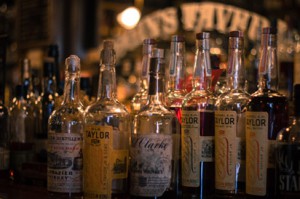 The Bottled-in-Bond Act guaranteed the liquid inside was actually whiskey, which was an issue of the time. In the name of greed, some less-than-reputable distillers would use iodine and tobacco to color their product in order to save on work and cost. This problem was solved with bonded whiskey – this meant it was stored in a federally bonded warehouse under U.S. government supervision, where taxes didn’t have to be paid on the whiskey until it was bottled and taken out of the warehouse for sale or shipping to the retailer. The whiskey had to meet certain requirements to qualify for this tax break; it had to be straight whiskey, distilled in a single season by one distillery, and bottled at 100 proof (100 proof whiskey contains 50% alcohol by volume. Nowadays, most whiskies are bottled at between 80 and 90 proof but this can vary). It also had to be stored in the bonded warehouse for at least four years before bottling. The federal government put its own green tax strip on every bottle until around 1984. People looked to the government as the authority to guarantee the product they were buying was actually whiskey, and as a result, Bottled-in-Bond whiskey became highly sought after in the early 20th century, and still is by collectors like Seiichiro today.
The Bottled-in-Bond Act guaranteed the liquid inside was actually whiskey, which was an issue of the time. In the name of greed, some less-than-reputable distillers would use iodine and tobacco to color their product in order to save on work and cost. This problem was solved with bonded whiskey – this meant it was stored in a federally bonded warehouse under U.S. government supervision, where taxes didn’t have to be paid on the whiskey until it was bottled and taken out of the warehouse for sale or shipping to the retailer. The whiskey had to meet certain requirements to qualify for this tax break; it had to be straight whiskey, distilled in a single season by one distillery, and bottled at 100 proof (100 proof whiskey contains 50% alcohol by volume. Nowadays, most whiskies are bottled at between 80 and 90 proof but this can vary). It also had to be stored in the bonded warehouse for at least four years before bottling. The federal government put its own green tax strip on every bottle until around 1984. People looked to the government as the authority to guarantee the product they were buying was actually whiskey, and as a result, Bottled-in-Bond whiskey became highly sought after in the early 20th century, and still is by collectors like Seiichiro today.
It is the whiskies with the Bottled-in-Bond seal in particular that he seeks out on his twice-yearly trips to the States. Using his property in Lexington, Kentucky as a base, Seiichiro drives the back roads and byways searching for outof- the-way liquor stores with the hope of uncovering more of this coveted liquid gold. He sets out after dark so, like a moth to a flame, he can spot on the horizon the bright neon lights of a bottle shop that might have remained hidden during the day. Seiichiro is so well-known for his love of the U.S. and passion for whiskey, that he is recognized as an honorary Kentucky citizen and has been made a Kentucky colonel.
“They don’t make them like they use to” Seiichiro says with a smile, and it’s true. Time capsules in a bottle, they each bring back a taste and a smoothness many modern whiskies and bourbons don’t hold. Unlike wine, whiskey is not expected to change much over time in the bottle. Seiichiro believes each sip is a chance to sample a piece of history, in effect the same beverage drinkers were partaking of a hundred years ago.
Because of Seiichiro’s journey, Rogin’s Tavern in Moriguchi has everything a whiskey lover could wish for. The smooth jazz sounds blend effortlessly with the sentimental bar decor and the scent of vintage spirits, transporting visitors to another time and place. “Sip and dream” Seiichiro says with a nostalgic smile, “sip and dream”.
Rogin’s Tavern
Access: Keihan line, Moriguchishi Stn (just outside the west exit) Open: Mon to Sat 5pm–2am
Closed: Sundays (except 3rd Sunday of each month)
Tel: 06-6997-3200
呂仁の ウイスキー 賛歌
が、最初の一口で好きになったわけではないという。若い巽が初めてウ イスキーを飲んだのは、大阪のリーガロイヤルホテルの地下だった。「焼 けるような感じで、飲みにくかった」と彼は笑いながら回想する。だがそ の夜を境に、何かが心に火を点けた。やがて導かれるように、何度もアメ リカに足を運ぶことになったのである。ケンタッキーやテネシーで酒屋 の棚をくまなく探し、日本に送るヴィンテージボトルを求めて遠くシカゴ やニューヨークまで足を伸ばした。お目当ての品は「ボトルド・イン・ボン ド」や「ボンデッド」と呼ばれるウイスキー。1897年発令の「ボトルド・イ ン・ボンド法」に則って製造されたストレートウイスキーで、課税済である ことを証明する緑色のシールが目印だ。
ボトルド・イン・ボンド法は、ボトル内の液体が間違いなくウイスキーであ ることを保証するための法令だった。当時は、ヨウ素やタバコなどで色 付けをした粗悪なウイスキーを出荷して、労力と時間を節約しようと目 論む蒸留所が少なくなかったのである。「ボンデッド・ウイスキー」は、米 国政府の監督のもと、連邦政府の保税倉庫で樽のまま保存される。出荷 のために瓶詰めされて初めて酒税がかかる仕組みだ。この優遇税制措 置を受けるには、いくつかの条件が課せられる。ストレートウイスキーで あること。単一の蒸溜所がその年に蒸留した原酒だけを瓶詰めするこ と。100プルーフ(アルコール度数50%)であること(現代は80〜90プ ルーフが主流)。さらに保税倉庫では、瓶詰めの前に最低4年間貯蔵しな ければならない。1984年頃まで、連邦政府は独自の課税済みシールを 全ボトルに添付していた。目の前の商品が本物のウイスキーであると確 信するため、人々は政府の権威をあてにしたのである。その結果、ボトル ド・イン・ボンド・ウイスキーは20世紀初頭より人気を集め、現在でもコレ クター垂涎の品となっている。
巽は年2回のアメリカ出張で、このボトルド・イン・ボンド・ウイスキーを探 しまわる。ケンタッキー州レキシントンに所有する拠点から、憧れの銘酒 との出会いを夢見て、裏道や脇道に車を駆って地方の酒屋を訪ねる。日 中は目立たない酒屋のネオンを見落とさないよう、飛んで火にいる夏の 虫のごとく夕方から行動する。 巽の米国好きとウイスキーに懸ける情熱 は当地でも有名だ。ケンタッキー州からは名誉市民と認められ、功績の あった民間人に送る「カーネル」の称号が授与されている。
「今では、もう昔のような製法でウイスキーを造らなくなりました」と、巽 は言う。事実、ボトルの中には、タイムカプセルが眠っている。スムーズ な舌触りも、独特な味わいも、現代の多くのウイスキーやバーボンには 見られない特徴だ。ワインとは異なり、ウイスキーは時を経てもボトルの 中で変質しにくい。だからこそ100年前の人たちと共に、歴史のかけら を味わうことができる。終わりのない旅は、守口のウイスキー愛好家に 極上の贈り物をもたらした。滑らかなジャズの調べは、センチメンタルな バーの装飾やヴィンテージスピリッツの香りと相まって、ここではないど こかへと客を連れていく。「口に含んで、空想してください」と、巽は静か に微笑む。そう、これは夢を見るためのお酒なのだ。
呂仁
アクセス: 京阪線守口市駅(西口を出てすぐ)
営業: 月曜日〜土曜日、午後5〜午前2
定休日: 日曜日(毎月第3日曜日は営業)
Tel: 06-6997-3200


